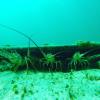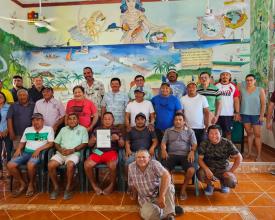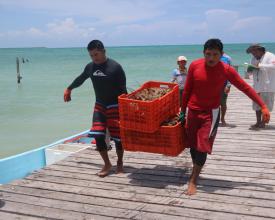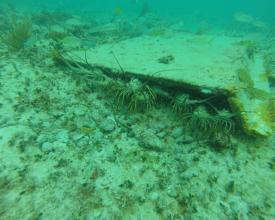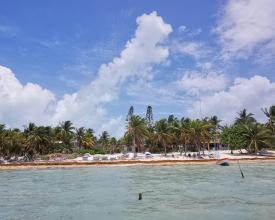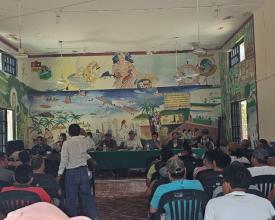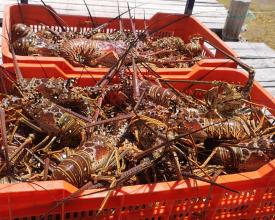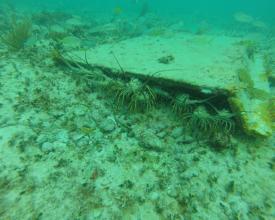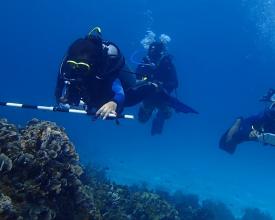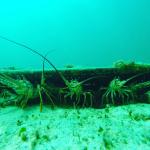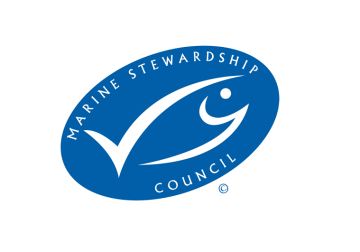Maintaining sustainability in the Caribbean lobster fishery in Bahía de la Asención.
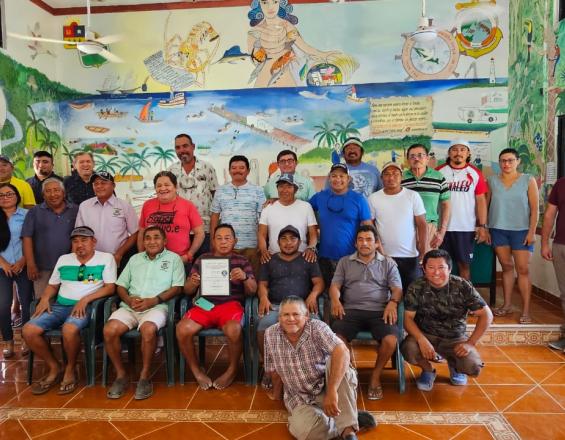
The Caribbean spiny lobster fishery has been for many years a resource of high economic value since 1960 for the fishing communities of Quintana Roo. As a result of this, the S.C.P.P. Vigia Chico dedicated to small-scale fishing has made a joint effort among the fishermen that make it up to adopt the most robust standard since 1990 through a fishery improvement project (Marine Stewardship Council MSC). We started this after a hurricane that affected the community socially and economically.
Thus, we began to have a healthy lobster population, generate the minimum environmental impact, and exercise effective management in the fishery, elements that are part of the MSC. To achieve this, we addressed management and governance through egalitarian processes, a robust monitoring system, knowledge of the effect of fishing on the ecosystem, co-investment, and co-management of the resource.
Context
Challenges addressed
- The limited financial resource capacity of all stakeholders to implement fishery improvements on an ongoing basis represents an economic challenge.
- Encouraging improved management and surveillance of the resource in the community, as well as aligning this objective with those of the stakeholders involved, has been a challenge in the social and governance sphere.
- The difficulty for good community and/or informal practices and agreements to be officially recognized and validated in favor of fisheries sustainability has been one of the management challenges.
- The inclusion of an ecosystem approach in fishery management, which identifies population dynamics and the effect of fishing on the ecosystem due to fishing activities, has also been an environmental and social management challenge.
Location
Process
Summary of the process
Fisheries are complex systems that involve ecological, social, environmental and management aspects to achieve sustainability. The actors involved in fisheries face challenges associated with each of these aspects, which are similar among fisheries, as reported by CEA Consultants in their review of fisheries improvement projects (at the international level) and PRONATURA (in Mexico).
The components of this solution work together to address: a) the lack of updated information, implementing a fishery monitoring system at the artisanal level and analyzing the impact of the fishery on the ecosystem; b) deficiencies in the management system through multi-sectoral alliances and an effective governance system; and c) gender equality, identifying the contribution of women in the value network.
Building Blocks
Co-management in the sustainable Caribbean lobster fishery in Bahia Asención, Mexico
It has been recognized that collective efforts and/or well-organized groups with a common vision and aligned objectives achieve greater benefits. This same principle has been used to promote sustainability in fisheries, adding multisectoral participation as a central axis; thus having a group integrated by various sectors of the region working together to have a sustainable fishery throughout the value network. In the lobster fishery, a broad group of fishermen and fisherwomen have formed strong alliances with research institutions (ECOSUR, Cinvestav, UNAM, SISIERRA, Universidad Marista), civil organizations (COBI), government (INAPESCA, CONAPESCA and Reserva de la Biósfera de Sian Ka'an) and the FAO to implement various improvements in the lobster fishery.FAO to implement various improvements in fisheries (fisheries monitoring, define reference points for fishery limits, participatory establishment of minimum size, exchanges between cooperatives and marketers, generation of savings funds) and thus make better decisions. These collaborative relationships have been formalized through various agreements and/or conventions that have allowed the relationship between institutions and fishing organizations in accordance with the changing needs of the fishery.
Enabling factors
- Integration of all sectors that may be involved in the fishery; leaving no one out ensures the path to sustainability.
- Transparency about the objectives and interests of each sector generates more robust and long-lasting alliances for continued collaboration.
- Organization among fishermen and fisherwomen, academic institutions, government agencies, and CSOs, since spiny lobster in the Caribbean is a resource of high economic value that is immersed in a complex network of stakeholders.
Lesson learned
- It is necessary to identify the areas of opportunity in the fishery found under the MSC standard assessment and jointly generate an action plan, in which each of the stakeholders involved can become involved due to their common interests.
- Close follow-up on the progress of the action plan and the agreements established with all the sectors involved (fishing organizations, government agencies, academic institutions, CSOs) strengthens the credibility of the project and generates trust for the achievement of common objectives.
- Constantly monitor the needs identified by fishermen and fisherwomen regarding the social and financial, management, and environmental aspects of the fisheries, in order to address challenges in a timely manner.
- Having strong governance within and of the fishing organization improves knowledge about the benefit to the fishery and decision making (e.g., internal regulations, sanction process for non-compliance with norms, laws, and/or assembly agreements).
Modeling the ecosystem with little data
By their nature, small-scale fisheries tend to have limited, poorly systematized data and short time scales. This scarcity of information represents a challenge for understanding, for example, the interaction of fishing gear with the ecosystem and its impact on the habitat; such information is fundamental in the implementation of a fishery improvement project. Around the world, different methodologies have been developed to generate information on the impacts of the fishery on the ecosystem; one of them is modeling based on the Ecopath program with Ecosim.
The civil organization COBI used this tool including information generated by fishermen and fisherwomen of our community (Punta Allen) through fishing logs, as well as biological and ecological information for the species that inhabit the fishing zones. In addition, to strengthen the model, the traditional ecological knowledge of our community was integrated through the application of interviews, from which relevant information was obtained about the diet of the species, their geographic distribution, reproductive season, etc.
Enabling factors
- The fact that fishermen and fisherwomen are generating information on fisheries through fisheries monitoring.
- It is important to integrate the traditional knowledge of fishermen and fisherwomen, since they have a large amount of important information about their natural environment and species.
- The results must be shared with the people of the fishing community, so that they value and appropriate their knowledge.
Lesson learned
- The process to obtain the results from the modeling (by Ecopath with Ecosim) can take about six months, since it is necessary to search for information, interview people in the community, analyze the information and make the models.
- It is important to socialize with the fishermen the importance and benefits of knowing the effects of the fishery on the ecosystem, and to let them know how their traditional knowledge is integrated in order to obtain more robust information for ecosystem management.
- The interviews conducted with the fishermen to record their traditional knowledge were long (approx. 40 minutes), which sometimes made them lose interest on the part of the interviewee. In addition, with respect to the time needed to conduct each of the interviews, the availability to interview more members could be scarce.
Community-based fisheries monitoring for robust and sustainable decision making
Small-scale fisheries face several challenges, one of the biggest and most important of which is obtaining information on the fishery. Particularly the information gaps in fisheries are reflected in the scarcity of knowledge on the state of the resource, the effects of the fishery on the ecosystem and the lack of compliance with existing regulations. This, in turn, makes it difficult to establish a solid baseline that explains the current state of the fishery and the way to improve its management and, in some cases, avoid its collapse. For the past couple of years, quantitative and qualitative data have been generated and shared among the fishing community, government, academia, and civil society organizations through Caribbean spiny lobster fishery monitoring. This allows inferences to be made about the health and population status of the species, the effects of extraction on the ecosystem, and compliance with national and regional regulations, implementing co-management based on the best available information. This represents the basis for implementing a fishery improvement project.
Enabling factors
- Involve the community in the collection of information on the resource, as well as encourage their commitment.
- Train the community in the correct collection of biological-fishing data through fishing logs.
- Build alliances between communities, academia, and governmental research institutions.
- Create a fishing logbook according to the needs of the fishery, integrating in the process the participation of academic, government, and the communities themselves.
Lesson learned
- Ensuring the design and implementation of fishery monitoring on an ongoing basis by fishermen and fisherwomen allows for the establishment of a robust baseline of information on the fishery.
- Sharing the information generated by the fishing community with the government sector and academia has allowed it to be duly analyzed and used to generate management strategies at the local level, for example, increasing the minimum catch size by 5 cm.
- Training fishermen and fisherwomen on the importance and necessity of having information on catches, species, fishing gear used, expenses generated during the fishing day, etc., has allowed us to develop governance over fishing resources and their environment.
Gender participation in the lobster fishery value network
The S.C.P.P. Vigía Chico, which is immersed in the fishery improvement project, has been developing good practices to achieve sustainable fishing, but fishing had been perceived and managed only as an extractive activity, and not as a complex system that encompasses other stages along the value network. It was on this basis that the cooperatives began to analyze and diagnose the participation by gender in each link of the value network. Thus, it was possible to visualize that the composition of the links encompasses activities in which women play a crucial role not only because they perform the activity itself (e.g., administration, transportation, processing, marketing, storage, landing, preparation of supplies) but also because the complementary activities (e.g., generation of citizen science, provision of services, family support) play an important role in achieving the objectives of resource conservation and sustainable fishing.
Enabling factors
- Create participatory workshops with people of different occupations, age, gender and social position, with knowledge of the fishery.
- Conduct an in-depth reflection and diagnosis of women's participation in the fisheries and in the community.
- Map the gender composition of the value network at each stage (pre-production, production, post-production, and activities complementary to production), including direct, indirect, paid and unpaid work.
Lesson learned
- To achieve an inclusive environment it is necessary to understand the fishery as a system, taking into account the norms and values of society, the roles played at each stage of the value network, and the paid and unpaid jobs.
- Recognize that cultural and gender divisions throughout the history of the fishery have kept women less involved in terms of voice and vote within fishery organizations, and this keeps them away from being able to occupy leadership positions.
- Emphasizing how gender equality contributes to fishery improvement projects and to the sustainability of fisheries increases the likelihood that fishing communities will adopt a gender perspective in their projects.
- Women have a greater contribution in pre- and post-production links as well as in complementary activities (e.g., biological monitoring), providing available information for resource management decision-making.
Impacts
- International recognition as a "good consumption option" in the Monterey Bay Aquarium's Seafood Watch.
- Close collaboration between the productive sector and the academic sector in the management of the fishery, to generate joint information on the resource through a fishery monitoring system.
- Scores over 80 in 25 of the 28 indicators of the standard established by the MSC, due to good management and governance.
- Good management measures (e.g., adding 5 cm to the minimum size as a precautionary rule, and community surveillance) taken voluntarily by the cooperative.
- The fishery operates in such a way that the resource is not overexploited, while maintaining the structure and function of the ecosystem on which the fishery depends.
Beneficiaries
Community fishermen and their families, about 350 people.
Sustainable Development Goals
Story
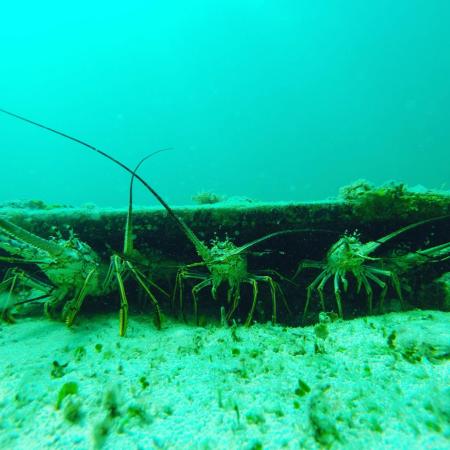
In the heart of Quintana Roo a small fishing community was formed in the 50's called Punta Allen; in the beginning the economy was based on the copra that was extracted from the coconut, with the passage of time going to the sea for food became the economy of the population. The fishermen understood that resources had to be used habitually because some were scarce, such as fresh water, since they depended on rainwater. When commercial fishing began, the bases of exploitation and teamwork were useful to carry out the fishing. This is how the SCPP Pescadores de Vigia Chico was born, organizing, planning, making agreements that benefit the community but most importantly preserving the sites where grandparents, parents and children can continue to enjoy the benefits of this place.
